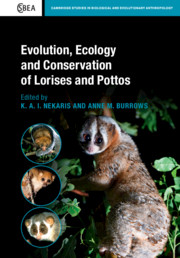Book contents
- Evolution, Ecology and Conservation of Lorises and Pottos
- Cambridge Studies in Biological and Evolutionary Anthropology
- Evolution, Ecology and Conservation of Lorises and Pottos
- Copyright page
- Dedication
- Contents
- Contributors
- Foreword
- Acknowledgements
- 1 Introduction
- Part I Evolution, Morphology and the Fossil Record
- Part II Ecology and Captive Management
- Part III Research, Trade and Conservation
- 24 Trapping, Collaring and Monitoring the Lorisinae of Asia (Loris, Nycticebus) and Perodicticinae (Arctocebus, Perodicticus) of Africa
- 25 Evaluation of Field Techniques Used to Assess Populations of Pottos and Lorises
- 26 Occupancy Modelling as a Method to Study Slender Loris Density
- 27 Using Accelerometers to Measure Nocturnal Primate Behaviour
- 28 Distribution and Conservation Status of Slow Lorises in Indo-China
- 29 Wildlife Trade Research Methods
- 30 Online Imagery and Loris Conservation
- 31 Slow Lorises (Nycticebus spp.) as Photo Props on Instagram
- 32 Integrating Science and Puppetry to Inspire Teenagers in Rural Asia to Value Slow Lorises
- 33 Developing a Rescue and Rehabilitation Centre as a Reaction to the Extensive Illegal Wildlife Trade in Slow Lorises
- References
- Index
24 - Trapping, Collaring and Monitoring the Lorisinae of Asia (Loris, Nycticebus) and Perodicticinae (Arctocebus, Perodicticus) of Africa
from Part III - Research, Trade and Conservation
Published online by Cambridge University Press: 29 February 2020
- Evolution, Ecology and Conservation of Lorises and Pottos
- Cambridge Studies in Biological and Evolutionary Anthropology
- Evolution, Ecology and Conservation of Lorises and Pottos
- Copyright page
- Dedication
- Contents
- Contributors
- Foreword
- Acknowledgements
- 1 Introduction
- Part I Evolution, Morphology and the Fossil Record
- Part II Ecology and Captive Management
- Part III Research, Trade and Conservation
- 24 Trapping, Collaring and Monitoring the Lorisinae of Asia (Loris, Nycticebus) and Perodicticinae (Arctocebus, Perodicticus) of Africa
- 25 Evaluation of Field Techniques Used to Assess Populations of Pottos and Lorises
- 26 Occupancy Modelling as a Method to Study Slender Loris Density
- 27 Using Accelerometers to Measure Nocturnal Primate Behaviour
- 28 Distribution and Conservation Status of Slow Lorises in Indo-China
- 29 Wildlife Trade Research Methods
- 30 Online Imagery and Loris Conservation
- 31 Slow Lorises (Nycticebus spp.) as Photo Props on Instagram
- 32 Integrating Science and Puppetry to Inspire Teenagers in Rural Asia to Value Slow Lorises
- 33 Developing a Rescue and Rehabilitation Centre as a Reaction to the Extensive Illegal Wildlife Trade in Slow Lorises
- References
- Index
Summary
Nocturnal animals are difficult to see and follow, especially in dense rainforest conditions. Nocturnal research is fraught with difficulties not encountered by individuals who study animals in the day, from the need for expensive equipment, constant access to power supplies to run lights and potential for increased encounters with dangerous wildlife. The main drawback of nocturnal fieldwork is that it is simply more difficult to find and continuously observe an animal at night. Through hard work and perseverance it is possible to obtain ecological data on lorises and pottos in the absence of radio tracking (e.g. Das et al., 2014; Nekaris, 2001; Pliosungnoen et al., 2010). Much more detail can be obtained, however, through capturing, measuring, collaring and monitoring nocturnal primates. The essential nature of radio tracking for the study of the behaviour and ecology of nocturnal primates has been recognised since the 1970s (e.g. Charles-Dominique, 1977a; Charles-Dominique and Bearder, 1979), and is by most researchers considered a must for thorough research (Sterling et al., 2000). Radio-tracking studies of lorises and pottos remain limited (2000; Millspaugh and Marzluff, 2001). In this chapter, we review the methods for trapping and collaring slow lorises and pottos, as well as provide a case study of the importance of red light for observing their behaviour in a humane and productive manner (see Box 24.1).
- Type
- Chapter
- Information
- Evolution, Ecology and Conservation of Lorises and Pottos , pp. 279 - 294Publisher: Cambridge University PressPrint publication year: 2020



